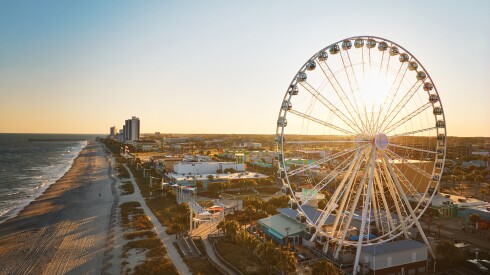Summer stargazers in Jackson Hole will have a whole new reason to look up—the local airport and county just received the world’s first DarkSky International certifications for their categories. In April, Teton County, Wyoming, became the first county to receive the designation as an International Dark Sky Community, and Jackson Hole Airport, the only U.S. commercial airport located in a national park (Grand Teton National Park), became the world’s first airport to become certified as an Urban Night Sky Place.
“Lack of light pollution overall, high elevation, and low moisture content in the air is what makes this place pretty amazing for stargazing,” says Samuel Singer, executive director of Jackson-based nonprofit Wyoming Stargazing.
While the airport must maintain Federal Aviation Administration (FAA) lighting standards for areas like the airfield and aircraft parking area, it was able to reduce light pollution in other areas by upgrading hundreds of lighting fixtures, adding motion sensors, and switching off ticketing screens within the check-in area at night, among other measures. Teton County’s designation only covers municipally held lands, although Wyoming Stargazing is working with partners to hopefully one day create an International Dark Sky Reserve in the Greater Yellowstone Ecosystem that incorporates federal lands.
And the night sky is likely to grow even darker, as the designations represent a five-year commitment toward a goal of becoming fully dark sky compliant by 2030.

Jackson Hole Airport is located within Grand Teton National Park with not much else around, and it’s the first dark sky airport.
FromAbove/Shutterstock
Where to go stargazing in Jackson Hole
To fully take advantage of the new designations, on a clear night, drive to Grand Teton National Park to enjoy the celestial show. You can stop at a roadside pullout by Antelope Flats or head to the darker, northern stretches of the park near Colter Bay, Lizard Creek Campground, or Leeks Marina. Intrepid backpackers can find even darker skies by reserving a backcountry campsite deep within the park.
In Jackson Hole, Snow King Mountain’s observatory offers daytime programming, as well as evening stargazing experiences. Purchase a ticket in advance, and ride the gondola up to 8,000 feet to see the planetarium and peer through the one-meter telescope. Wyoming Stargazing offers free weekly public stargazing on clear Thursday nights in Rendezvous Park (also known as “R Park”) along the Snake River, in addition to other programming.
Any clear night is a good time to gaze at the night sky, but during the Perseids meteor shower is an especially rewarding time to look up, with up to 100 meteors visible per hour. This year’s peak is expected to be August 12–13. During periods of high solar activity, the northern lights also are sometimes visible from Jackson Hole.
“It’s worth it if you’re coming to visit here to take the time to be up in the middle of the night and peer at the sky for a few minutes,” says Erik Kimball, Teton County, Wyoming’s Sustainability Coordinator.
During June, “astronomical twilight,” when the sky is considered darkest and when peak stargazing opportunities present themselves, ranges from around 11:30 p.m. to 3:30 a.m., though you can still see stars beyond those hours.
“It’s incredible. It’s moving, especially for someone who’s never experienced it,” said Kimball, adding, “It’s almost religious in a sense, such a beautiful wonder of nature, and people should take the time while they’re here to enjoy it, even for just a brief moment.”








